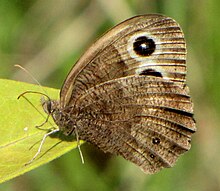Cercyonis pegala
| Cercyonis pegala | ||||||||||||
|---|---|---|---|---|---|---|---|---|---|---|---|---|

Cercyonis pegala |
||||||||||||
| Systematics | ||||||||||||
|
||||||||||||
| Scientific name | ||||||||||||
| Cercyonis pegala | ||||||||||||
| ( Fabricius , 1775) |
Common wood-nymph is a butterfly ( butterfly ) from the family of Nymphalidae (Nymphalidae).
features
butterfly
The fore wing length of the moths averages 26 millimeters in the males and 30 millimeters in the females. They are therefore significantly larger than other species of the Cercyonis genus . Fore and hind wings are brown in color on the upper and lower sides. In the light brown to orange-yellow postdiskal and submarginal region of the upper side of the forewing, there are two large, black, white nucleated eye spots , the lower of which is usually larger than the upper. The upper side of the hind wings is mostly without drawing, sometimes with a small eye spot. The undersides of the wings are marbled brown. On the forewings the colors and eye-spots on the upper side shine through to the rear; on the hind wings, the number of different sized eye-spots varies depending on the area of occurrence, usually between one and six.
egg
The eggs are whitish when they are laid, but soon take on a dark color and tend to be scattered randomly near grasses. A female lays up to 300 eggs.
Caterpillar
Younger caterpillars have a yellowish color, various red-brown side stripes and are short haired on the entire body. Adult animals are colored green, show dark side stripes and are dotted yellow-white along the entire length of their body, including the head. Two short reddish tips can be seen at the end of the body.
Doll
The falling doll always has a green base color, but varies depending on the area of occurrence in the drawing elements. So it can be covered with white, yellow or black stripes.
Similar species
Cercyonis sthenele differs due to the smaller forewing length, which is an average of 22 millimeters in males and 24 millimeters in females, and in that the lower eye spot on the upper side of the forewing is smaller than the upper. The species occurs only in the western United States .
Subspecies
In addition to the nominate form Cercyonis pegala pegala (Fabricius, 1775), the following subspecies are distinguished:
- Cercyonis pegala abbotti (Brown, 1969)
- Cercyonis pegala alope (Fabricius, 1793)
- Cercyonis pegala ariane (Boisduval, 1852)
- Cercyonis pegala blanca (Emmel & Mattoon, 1972)
- Cercyonis pegala boopis (Behr, 1864)
- Cercyonis pegala damei (Barnes & Benjamin, 1926)
- Cercyonis pegala ino (Hall, 1924)
- Cercyonis pegala nephele (Kirby, 1837)
- Cercyonis pegala olympus (Edwards, 1880)
- Cercyonis pegala stephensi (Wright, 1905)
- Cercyonis pegala texana (Edwards, 1880)
- Cercyonis pegala wheeleri (Edwards, 1873)
Distribution and occurrence
The range of the species extends from Nova Scotia and New Brunswick west to British Columbia and south to California , Texas and Florida . It has also been detected in Mexico . Cercyonis pegala prefers to colonize open grass and prairie landscapes as well as forest edges.
Way of life
The moths fly in one generation from June to September. They like to visit different flowers to take in nectar. They also suckle less often on injured trees, damp ground or manure. The caterpillars feed on various grasses, for example of the genus Andropogon or Tridens flavus . Meadow bluegrass ( Poa pratensis ) is also accepted for breeding . The pupa hibernates.
supporting documents
Individual evidence
- ↑ a b c d e James A. Scott (1986). The Butterflies of North America: A Natural History and Field Guide. Stanford, California: Stanford University Press. ISBN 0-8047-2013-4 , pp. 240/241
- ↑ Photos of butterflies http://www.butterfliesofamerica.com/cercyonis_pegala_alope_live2.htm
- ↑ caterpillar pictures http://butterfliesofamerica.com/cercyonis_pegala_texana_immatures.htm
- ↑ Distribution and subspecies http://www.nic.funet.fi/pub/sci/bio/life/insecta/lepidoptera/ditrysia/papilionoidea/nymphalidae/satyrinae/cercyonis/index.html#pegala
literature
- James A. Scott (1986). The Butterflies of North America: A Natural History and Field Guide. Stanford, California: Stanford University Press. ISBN 0-8047-2013-4 , pp. 240/241
Web links
- eol.org - Encyclopedia of Life


